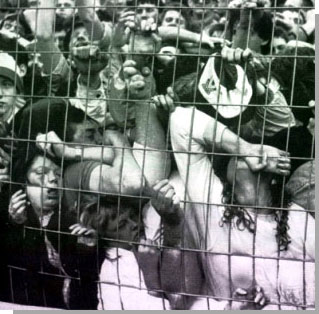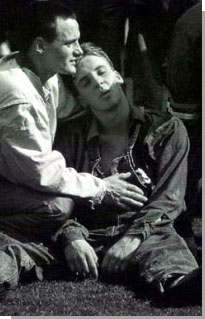 Chris Parsonage will probably always be a soccer fan.
But he may think twice about ever going to another match.
For the rest of his life, he will remember April 15, 1989---when
an afternoon soccer game turned into a deadly stampede.
Chris Parsonage will probably always be a soccer fan.
But he may think twice about ever going to another match.
For the rest of his life, he will remember April 15, 1989---when
an afternoon soccer game turned into a deadly stampede.
Chris, a 29-year-old math teacher, was looking forward
to Saturday’s soccer match at Hillsborough Stadium in heffield,
England. He lived just outside the city of Liverpool, and
he had been excited about the game all week. He was planning
to watch Liverpool’s team play in the semifinal match for
the national cup. Liverpool fans love their soccer team,
so Chris knew the stadium would be crowded.
Soccer is tremendously popular all over Europe, and English
fans are famous for their team loyalty. But that loyalty
has sometimes gotten out of hand. Mobs
of supporters have damaged property and started deadly brawls
with rival fans. In fact, English soccer fans have been
so violent that for several years their teams were barred
from European competition.
But Chris Parsonage didn’t expect any trouble at Saturday’s
playoff game. He and two friends arrived at the stadium
and began to make their way through the crowded turnstiles.
His friends had tickets for seats in the stands, but Chris
was headed for the terrace
behind the Liverpool goal. It was cheaper than his friends’
seats because it had standing room only.
Local police and England’s soccer association knew that
soccer matches had a reputation for violence. And Liverpool
fans were especially prone
to brawls. So officials had erected security fences at either
end of the field, between each terrace and goal. They hoped
the steel mesh would keep Liverpool fans from pouring onto
the field to attack the fans of the rival team.
Outside the turnstiles, the crowd began to thicken as
Liverpool fans gathered at their gate. Most people in the
crowd did not have tickets. They came to the match planning
to buy them at the door. But for some reason, fans of Liverpool’s
opponent, Nottingham Forest, had been allotted more tickets.
So while the rival fans streamed in at their gate, many
Liverpool fans were forced to wait outside.
Angry and noisy, the fans milled around the gate. The
crowd had swollen to 3,000 people by now. And police began
to rear a riot. To keep the pressure from building up outside
the arena,
an officer opened a gate to the stadium.
Meanwhile, Chris Parsonage had managed to get through
the turnstiles .He walked along the tunnel that led from
the gate to the terrace. Nearby he heard someone mention
that the police had opened the gates behind him, but he
wasn’t worried. He said later, “Everyone was pushing forward
to get in and see the kickoff, but I had been in crowds
like this before.”Confident that he would find a place to
stand, Chris just wasn’t prepared for the chaos that happened
next.
He made his way to the terrace and tried go move to a
place where he could see the game. But then he realized
that he was trapped. The crowd was so tight that he could
not move to either side, and the situation was getting worse.
He felt the pressure building up behind him like the swell
of a giant wave. Thousands of fans had now surged through
the tunnel.
Chris and the people around him were lifted off their
feet from the extreme pressure. One of Chris’s legs was
pulled forward while the other was trapped against a barrier.
He began to scream. “I honestly thought my leg would snap,”
he remembered, “and I was panicking.”
All around him people were screaming and fainting. He
watched in horror as a man in front of him turned blue.
But there was nothing Chris could do to help His arms and
legs were pinned by the crowd around him.
The fans tried yelling for the police to stop the game.
But they couldn’t scream for long because they had to save
their breath Chris said he struggled to keep his mouth up
high so that he could keep breathing
At the front of the terrace, hundreds of fans were pressed
against the steel-mesh security fence, as the crowd continued
to squeeze forward. Some people fell and were trampled,
while others were crushed to death against the 10-foot-high
immovable fence. Bill Eastwood, a safety expert who was
present at the disaster, said, “There must have been a half
ton of pressure across each person’s midriff.”
Chris Parsonage was lucky. Somehow the surge
of the crowd pushed him into an empty seat He sat there
for am hour and a half, unable to walk on his injured leg
He recalled, “I started shaking and crying because I knew
very well I could have been dead. I could see all those
people being carried away like dolls in a toy shop, with
arms hanging all over the place.”
Ninety-four fans were killed in the stampede. And nearly
200 more were injured Many of the dead were children and
teenagers. Who had been crushed and suffocated by a crowd
of taller adults.
Chris Parsonage, who is more than six feet tall, believes
that his height saved his life
Amazingly, many people at the soccer match had no idea
that fellow fans were being pressed to death. Because the
people on the terrace couldn’t breathe, they also couldn’t
scream so the danger wasn’t realized until it was too late.
Soccer officials, unaware of the tragedy, did not call off
the match immediately. The players on the field continued
the game for six minutes while their fans were being killed
in front of them.
The tragedy at Sheffield is just one example of the ongoing
problem with English soccer crowds. And some researchers
believe that the stadiums themselves are the cause of many
incidents. A number of popular stadiums are small and outdated.
Others are built in cramped city neighborhoods, where there
is no room to organize a crowd. Some people believe that
if England wants to avoid crowd disasters in the future,
the country must invest in larger, more modern stadiums.
They will make police security easier and safer. And they
will also attract families who are now afraid to attend
soccer matches.
But a new stadium won’t make Chris Parsonage forget Sheffield,
“I still wake up crying in the middle of the night and see
that guy’s face in front of me. At the stadium I think I
was crying because I was alive. Now I don’t know. I think
I am crying for the dead.”
↑TOP (1097
words)
|